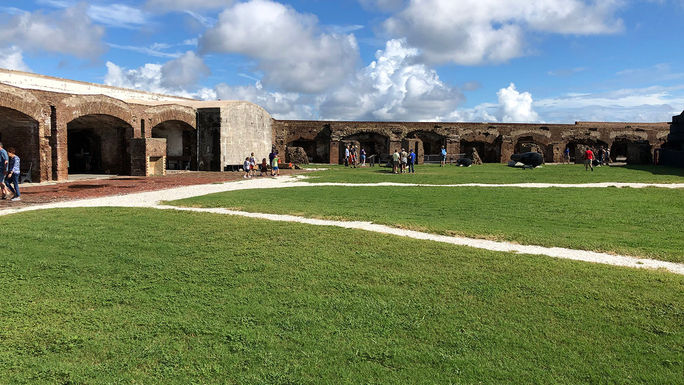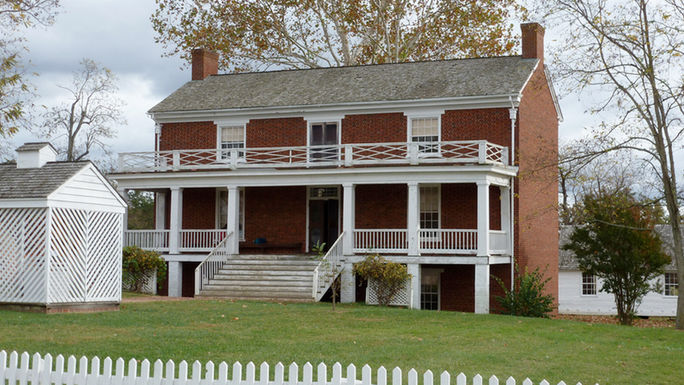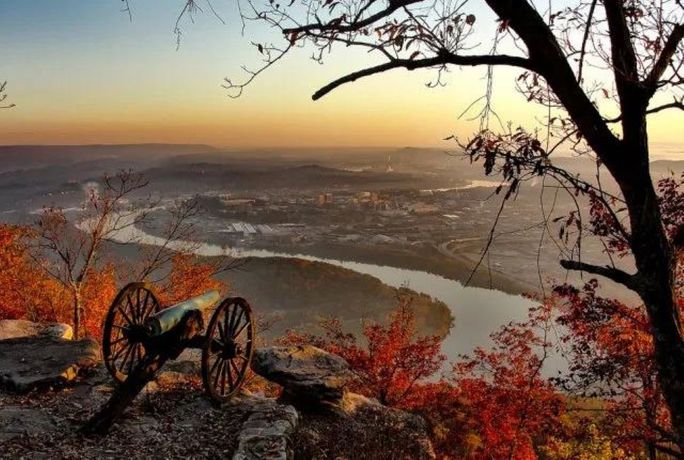
Veterans Day is a national holiday observed annually on
November 11 to honor American veterans of all wars.
While Memorial Day honors those who died in military
service, Veterans Day celebrates all who served, living or deceased during war
or peacetime. Parades, speeches and wreath-laying ceremonies occur
nationwide, with the most notable ceremony held at the Tomb of the Unknown Soldier in
Washington, D.C.
Lovers of military history can tour battlefields across the
globe, each telling a unique story, though many can be visited here within the
U.S., providing a deeper understanding of history and the events that shaped the United States’ conflicts. These are some of the most well-known
sites.
Normandy, France

The memorial at the Normandy American Cemetery in Normandy, France. (Photo Credit: Lacey Pfalz)
The site of the pivotal D-day landings on June 6, 1944, Normandy,
in northern France represented the beginning of the Allied liberation of
Western Europe during World War II. German forces fiercely defended the Normandy
beaches, most notably at Omaha Beach, where U.S. troops faced heavy casualties and
almost 4,000 Allied soldiers died on D-Day.
Today, visitors can find monuments and signs around the
beaches where the battle raged along with several cemeteries offering a silent but
strong testimony with their countless rows of tombstones, including the
infamous Normandy American Cemetery.
Gettysburg, Pennsylvania

PHOTO: Monuments and canons like these just north of Devil’s Den can be found throughout the Gettysburg National Military Park and are stops on bus tours. (photo by Dan Callahan)
Often considered the turning point of the Civil War, the
three-day battle of Gettysburg from July 1-3, 1863, was one of the largest and bloodiest
of the Secession War with more than 50,000 killed, injured, captured or missing.
To embrace its place in history, the city of Gettysburg preserved
the battlefield as the Gettysburg National Military Park that attracts millions
of visitors every year as a symbol of sacrifice, remembrance and the enduring
struggle for equality. The park spans over 6,000 acres and includes more than
1,300 monuments, markers and memorials along with exhibits at the Gettysburg
Museum and Visitor Center.
Fort Sumter, Charleston, South Carolina

Interior of Fort Sumter, which is strategically located at the mouth of Charleston Harbor. (Photo by Paul Heney)
The first shots of the Civil War were fired at this historic
sea fort in Charleston Harbor on April 12, 1861. As a result, Fort Sumter
became a symbol of Union resistance and Confederate defiance.
Today, the bastion is part of the Fort Sumter and Fort
Moultrie National Historic Park, managed by the National Park Service. Visitors
can explore the ruins, museum exhibits and even take boat tours from Charleston
to the island.
Pearl Harbor, Hawaii

Pearl Harbor with USS Arizona and USS Missouri (Photo Credit: Michael Kompanik)
The historic lagoon harbor on the island of Oahu is renowned
for the surprise attack by the Japanese military on December 7, 1941, that
President Franklin D. Roosevelt called “a date which will live in infamy.”
The site is preserved as the Pearl Harbor National Memorial,
managed by the National Park Service. Key visit features include the USS
Arizona Memorial which stands over the sunken battleship, honoring the crew
members who died in the attack and the USS Missouri, the site of the Japanese
surrender in 1945.
Yorktown, Virginia

Yorktown, Virginia Fife & Drum Reenactment (Photo Credit: Michael Kompanik)
The Battle of Yorktown in October 1781 was the American
Revolution’s final battle, leading to the signing of the Treaty
of Paris two years later. The three-week battle ended in British
surrender, ultimately paving the way for American independence.
The battlefield has been preserved as part of the Colonial
National Historical Park which includes Jamestown and parts of the Colonial
Parkway. Visitors can explore Surrender Field, Yorktown Battlefield Visitor
Center and the Historic Yorktown village with its 18th century buildings
and museums.
Antietam, Maryland

Antietam National Battlefield. (Photo via Doug Kerr / Flickr / Creative Commons)
Though the Battle of Antietam was considered a Union
victory, it remains the bloodiest single day in American military history with over
22,000 casualties. Following the battle, President Lincoln issued the
preliminary Emancipation Proclamation on September 22, 1862.
Considered one of the most picturesque, pristine and
well-preserved Civil War battlefields, Antietam is a must-see for veterans and
Civil War buffs. The area is preserved as Antietam National Battlefield and managed
by the National Park Service where visitors can explore key sites like Bloody
Lane, Burnside’s Bridge and Dunker Church.
Manassas, Virginia
The First Battle of Bull Run, also known as the Battle of
Manassas, was the first major land battle of the Civil War and the place where General
Thomas J. Jackson earned the nickname “Stonewall” for his steadfast defense.
Located in Prince William County, Virginia, the Manassas
National Battlefield Park spans over 5,000 acres, largely unchanged throughout
the years with monuments offering a vivid sense of what soldiers experienced
during the battles. Henry Hill Visitor Center offers an engaging film, exhibits
and ranger-led programs that explore the battles and their historic significance.
Vicksburg, Mississippi

Vicksburg (Photo via NatalieMaynor / flickr)
Vicksburg sat atop high bluffs overlooking the Mississippi
River, making it a vital Confederate stronghold. Showcasing the brilliant
strategy of General Ulysses S. Grant, the battle here was a decisive Union victory
during the Civil War that split the Confederacy in two, isolating Texas,
Louisiana and Arkansas from the rest of the South and cutting off Confederate supply
lines.
The historic site, preserved as Vicksburg National Historic
Park, features over 1,300 monuments and markers, the national cemetery, the
restored USS Cairo, an ironclad gunboat that sunk during the campaign and
walking and driving tours that trace battle sites and siege lines.
Chancellorsville, Virginia
Fought between April 30 to May 6, 1863, the Battle of
Chancellorsville is often called Confederate General Robert E. Lee’s greatest
victory during the Civil War. Despite the loss of Stonewall Jackson here, the
battle demonstrated Lee’s bold strategy in the face of a larger enemy. The
victory emboldened Lee to launch his second invasion of the North which led to
the Battle of Gettysburg two months later.
The battlefield is part of the Fredericksburg and
Spotsylvania National Military Park which includes preserved sites, walking
trails and interpretive exhibits.
Appomattox Court House, Virginia

Appomattox Court House National Historical Park. (Photo via btwashburn / Flickr / Creative Commons)
After months of siege at Petersburg and Richmond, General
Robert E. Lee’s Army of Northern Virginia was exhausted and outnumbered. On April 9, 1865, Lee surrendered to Union General Ulysses
S. Grant, marking the final chapter of the American Civil War and the start of
the nation’s healing.
The site of the surrender was Appomattox Court House. Visitors
can tour the McLean House, where the formal surrender documents were signed and
the property that was restored to its original appearance along with the Appomattox
Court House and over 1,700 acres of historical exhibits, walking trails and reenactments.
Chickamauga & Chattanooga National Military Park

Chattanooga, Tennessee (Photo Credit: Photo via Pixabay/10308)
This combined national military park spanning the border of
Georgia and Tennessee commemorates two pivotal battles that include Lookout
Mountain and Missionary Ridge. The oldest and one of the largest Civil War
battlefields in the U.S. was established as the nation’s first national
military park in 1890.
The park covers over 9,500 acres and includes sites in Fort
Oglethorpe, Georgia and Chattanooga, Tennessee, along with over 600 monuments,
a visitor center and Lookout Mountain offering spectacular panoramic views and
interpretive trails.
For the latest travel news, updates and deals, subscribe to the daily TravelPulse newsletter.

